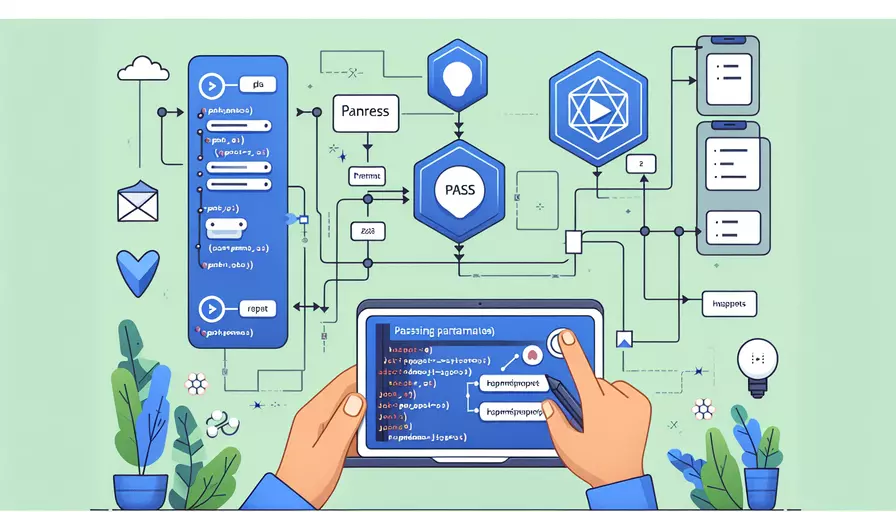
Vue传递父组件参数的方法主要有3种:1、使用props;2、使用事件总线(Event Bus);3、使用Vuex。 这些方法各有优缺点,适用于不同的场景。接下来,我将详细介绍这些方法及其应用场景、优缺点。
一、使用props
props 是Vue中最常用的父子组件传参方法。父组件通过在子组件标签上添加属性,将数据传递给子组件。
步骤:
- 在子组件中定义props属性。
- 父组件在子组件标签上使用属性绑定数据。
示例:
父组件(Parent.vue):
<template>
<div>
<Child :message="parentMessage"></Child>
</div>
</template>
<script>
import Child from './Child.vue';
export default {
data() {
return {
parentMessage: 'Hello from Parent!'
}
},
components: {
Child
}
}
</script>
子组件(Child.vue):
<template>
<div>
{{ message }}
</div>
</template>
<script>
export default {
props: {
message: {
type: String,
required: true
}
}
}
</script>
优点:
- 简单易用,适合父子组件关系明确且数据流动单向的情况。
缺点:
- 当组件层级较深时,props传递会变得复杂且不易管理。
二、使用事件总线(Event Bus)
事件总线是一种在Vue实例之间传递数据的方式。通过创建一个中央事件总线,可以在不使用props的情况下实现父组件和子组件之间的数据传递。
步骤:
- 创建一个事件总线实例。
- 在需要传递数据的组件中触发事件。
- 在接收数据的组件中监听事件。
示例:
创建事件总线(eventBus.js):
import Vue from 'vue';
export const EventBus = new Vue();
父组件(Parent.vue):
<template>
<div>
<Child></Child>
<button @click="sendMessage">Send Message</button>
</div>
</template>
<script>
import { EventBus } from './eventBus';
import Child from './Child.vue';
export default {
components: {
Child
},
methods: {
sendMessage() {
EventBus.$emit('message-from-parent', 'Hello from Parent!');
}
}
}
</script>
子组件(Child.vue):
<template>
<div>
{{ message }}
</div>
</template>
<script>
import { EventBus } from './eventBus';
export default {
data() {
return {
message: ''
}
},
mounted() {
EventBus.$on('message-from-parent', (data) => {
this.message = data;
});
}
}
</script>
优点:
- 适合兄弟组件或跨层级组件间的数据传递。
- 解耦组件,增加代码灵活性。
缺点:
- 事件总线过多时,容易导致事件管理混乱。
- 难以追踪数据流动,调试较为复杂。
三、使用Vuex
Vuex是Vue.js的状态管理模式,适用于大型应用程序中复杂的数据管理需求。通过Vuex,可以在全局状态中管理数据,实现父组件和子组件之间的数据传递。
步骤:
- 创建Vuex Store实例。
- 在组件中通过Vuex Store获取或更新数据。
示例:
创建Vuex Store(store.js):
import Vue from 'vue';
import Vuex from 'vuex';
Vue.use(Vuex);
export default new Vuex.Store({
state: {
message: ''
},
mutations: {
setMessage(state, message) {
state.message = message;
}
},
actions: {
updateMessage({ commit }, message) {
commit('setMessage', message);
}
}
});
父组件(Parent.vue):
<template>
<div>
<Child></Child>
<button @click="sendMessage">Send Message</button>
</div>
</template>
<script>
import { mapActions } from 'vuex';
import Child from './Child.vue';
export default {
components: {
Child
},
methods: {
...mapActions(['updateMessage']),
sendMessage() {
this.updateMessage('Hello from Parent via Vuex!');
}
}
}
</script>
子组件(Child.vue):
<template>
<div>
{{ message }}
</div>
</template>
<script>
import { mapState } from 'vuex';
export default {
computed: {
...mapState(['message'])
}
}
</script>
优点:
- 适合大型应用程序,提供集中式的状态管理。
- 易于调试和追踪数据流动。
缺点:
- 对于小型项目可能过于复杂。
- 需要一定的学习成本。
总结
在Vue中传递父组件参数的方法主要有三种:使用props、使用事件总线和使用Vuex。每种方法都有其适用场景和优缺点:
- 使用props:简单易用,适合父子组件关系明确且数据流动单向的情况。
- 使用事件总线:适合兄弟组件或跨层级组件间的数据传递,增加代码灵活性。
- 使用Vuex:适合大型应用程序,提供集中式的状态管理,易于调试和追踪数据流动。
根据具体需求选择合适的方法,可以提高代码的可维护性和可读性。对于初学者,建议从简单的props开始,逐步掌握事件总线和Vuex,以应对更复杂的应用场景。
相关问答FAQs:
1. Vue是什么?
Vue是一款流行的JavaScript框架,用于构建用户界面。它采用了组件化的开发方式,使开发人员能够轻松构建复杂的应用程序。Vue具有简洁的语法和高效的性能,同时也支持双向数据绑定和虚拟DOM,使得开发过程更加灵活和高效。
2. 如何传递父组件参数到子组件?
在Vue中,父组件可以通过props属性向子组件传递参数。下面是一个简单的示例:
父组件:
<template>
<div>
<child-component :parentProp="parentData"></child-component>
</div>
</template>
<script>
import ChildComponent from './ChildComponent.vue';
export default {
data() {
return {
parentData: 'Hello from parent component'
}
},
components: {
ChildComponent
}
}
</script>
子组件:
<template>
<div>
<p>{{ parentProp }}</p>
</div>
</template>
<script>
export default {
props: ['parentProp']
}
</script>
在上述示例中,父组件通过props属性将parentData传递给子组件,子组件通过定义props接收该参数并在模板中使用。
3. 如何在子组件中修改父组件传递的参数?
在Vue中,props属性默认是单向绑定的,即只能从父组件传递给子组件,子组件无法直接修改父组件的参数。但是,可以通过触发自定义事件的方式,让父组件监听到子组件的修改并做出相应的响应。下面是一个示例:
父组件:
<template>
<div>
<child-component :parentProp="parentData" @update-parent="updateParentData"></child-component>
<p>{{ parentData }}</p>
</div>
</template>
<script>
import ChildComponent from './ChildComponent.vue';
export default {
data() {
return {
parentData: 'Hello from parent component'
}
},
components: {
ChildComponent
},
methods: {
updateParentData(newData) {
this.parentData = newData;
}
}
}
</script>
子组件:
<template>
<div>
<button @click="updateParentProp">Update Parent Prop</button>
</div>
</template>
<script>
export default {
props: ['parentProp'],
methods: {
updateParentProp() {
this.$emit('update-parent', 'New data from child component');
}
}
}
</script>
在上述示例中,子组件通过this.$emit()方法触发了名为"update-parent"的自定义事件,并传递了新的参数。父组件通过监听该自定义事件,并在回调函数中修改了parentData的值,从而实现了子组件修改父组件参数的效果。
文章标题:vue是什么传递父组件参数,发布者:飞飞,转载请注明出处:https://worktile.com/kb/p/3533102

 微信扫一扫
微信扫一扫  支付宝扫一扫
支付宝扫一扫 